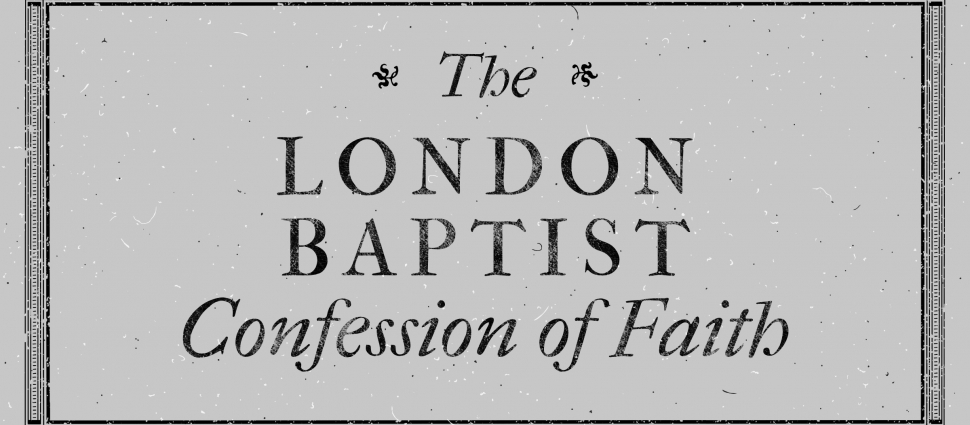Review of James Renihan's To the Judicious and Impartial Reader

Review of James Renihan, To the Judicious and Impartial Reader: A Contextual-Historical Exposition of the Second London Baptist Confession of Faith (Founders Press, 2022).
It’s rare when books promoted as landmark or groundbreaking actually are. But the publication of To the Judicious and Impartial Reader: A Contextual-Historical Exposition of the Second London Baptist Confession of Faith (Founders Press, 2022), by Dr. James Renihan, warrants hyperbole. With his second volume out of a projected three volume set on Baptist Symbolics, we finally have the commentary on the Second London Confession of Faith (2LCF) that we’ve lacked and sorely needed.
I first felt that need years before I became a pastor in a confessional Baptist church. After my wife gave me a gift edition of The Baptist Confession of Faith 1689 one Christmas, what I’d been seeing in Scripture was affirmed and furnished by the Confession’s careful articulation. But as I sought help to understand the confessional language better, I was surprised there was little help to be found. Most popular works on 2LCF seemed to ignore the Confession’s own wording and instead used its framework as an outline for their own theology. Treatments of the Confession’s language, its historical and theological precursors as well as the interpretive traditions it was founded upon, were hard to find – aside from isolated lectures, articles, and the occasional monograph. Now with the publication of Renihan’s exposition, the help that I looked for over 15 years ago is finally available.
If you’re familiar with James Renihan’s prior work in lectures and other books,[1] you will recognize his “contextual-historical” method (2) and its guiding principle: “From my perspective, the key question is what did the Confession mean? to its readers in its own context” (7).[2] To understand 2LCF according to its original intent, Renihan sets the language of 2LCF within the circumstances that gave rise to it. For example, the opening sentence that strengthens the doctrine of Scripture as “the only sufficient, certain, and infallible rule” in 1.1 was added when the rise of the Quakers, the resurgence of Roman Catholicism, and the broad use of the analogy of Scripture by paedobaptists variously threatened biblical authority (30-31).
Renihan also shows that the parts of the Confession that most puzzle modern Christians are far less indefensible as some claim. I’ve heard confessional Baptist pastors publicly joke that “the editors must have been asleep” by allowing “our first parents fell… and we in them” in 6.2, as it appears to contradict the imputation of Adam’s sin alone in Romans 5:12-21. But if you understand the Socinian denial of any relationship between Adam’s sin and his progeny (178-79), this wording was carefully chosen to maintain that our “first parents,” Adam and Eve, did indeed pass on sinful corruption by means of “ordinary generation,” as it says in 6.3.
Though perhaps more notorious is how 2LCF identifies “the Pope of Rome… is that antichrist” in 26.4. Renihan’s careful discussion (488-90) proves this assertion is typical of Protestant orthodoxy, which universally understood “antichrist” in Scripture not as an eschatological individual, but an ecclesiological institution set against Christ. Many readers will be surprised to learn that it was actually Roman Catholic apologists who argued for understanding the antichrist as a single individual expected in the future (490). Overall, Renihan’s historical spadework cautions us from rashly dismissing the confessional language by exposing its historical setting and vindicating the authors’ theological precision.
Still one of the most illuminating contributions of To the Judicious Reader is the careful attention to the Confession’s internal structure (11). Divided into four main sections – First Principles (chs. 1-6) to the Covenant (chs. 7-20), God-Centered Living (chs. 21-30), and the World to Come (chs. 31-32) – 2LCF sequentially and logically builds on foundational principles.
Renihan argues the first chapter of each section is introductory to the theme of the whole. This repays dividends to understanding the significance of chapters like ch. 21, “Of Christian Liberty,” as introducing the principles upon which the regulative principle of worship (ch. 22), church polity (ch. 26), and Christian ethics (chs. 23-25) are built. Regardless of how these issues are often caricatured today, they are intended to liberate Christians from the traditions of man, as “God alone is Lord of the conscience” (21.2).
The structural analysis proves that the Confession must be interpreted as a “woven document,” to be read “back and forth” (11). For example, the collocation of God’s “goodness, wisdom, and power” was a well-established theological formula with Trinitarian implications (38-39, 91, 129-31). It first appears in 2LCF in what is revealed by the “light of nature” in 1.1, but it also conceptually frames 2.2, is reiterated in discussions of creation and providence in 4.1, 5.1, and 5.4, and thematically reappears in “The Last Judgment” in 32. On that topic, Renihan reminds us:
In contemplating the last judgment we are reminded that we must do so in light of the doctrine of God expounded in chapter two and fleshed out in the rest of the Confession. All that has been said about Him provides a foundation for this final chapter (583-84).
This is demonstrative, not only of the foundational importance of the early chapters – like the doctrine of God in chs 3-5 - but also of a careful theological method that we are wise to relearn and employ today. Renihan shows Particular Baptists were a branch of the Reformed movement and sought to be catholic in the best sense of the term (3-4). That catholicity is noted throughout the exposition, including how 2LCF 8.2 more closely reflects the Nicene Creed than its predecessor, the Westminster Confession of Faith (219).
Renihan’s volume will prove invaluable to many categories of readers. Without question, every officer of every church that confesses 2LCF ought to read it, so that they understand what they’ve agreed to “hold firm… as taught” (Titus 1:9). Every pastor that wants to teach or write a popular exposition of 2LCF, or review the few now currently available, ought to reference Renihan’s work to discern anachronistic or idiosyncratic claims, as well as unstudied dismissals of the Confession’s language. Further, those who raise the question of confessional revision today, or who may hold to an elastic view of confessional subscription under that ubiquitous modern phrase, semper reformanda,[3] will find in this volume enough material to challenge their assumptions, focus their questions, and warn against any hasty dismissals of this carefully framed symbol.
Even readers outside confessional Baptist circles will benefit. Renihan’s focus on primary sources (7) makes it valuable for all who share the Reformed heritage from which 2LCF developed. Any serious Christian will find Renihan’s writing style and patient explanation useful for study, and, with each chapter concluding with Scripture and prayer, also for devotional meditation.
It's a true benediction to see the public attention the Second London Confession of Faith is receiving today. But many of those exploring or promoting “the 1689” are in the same place I was years ago – intrigued, but largely unsure of what 2LCF means. Fortunately, with Renihan’s “contextual-historical exposition,” they and the generations to come do not have to remain there. We finally have the commentary that we’ve needed. As Chad Van Dixhoorn writes in the Foreward, Renihan has given us “the standard reference works in this field for many years” (xviii).
Steve Meister, Pastor, Immanuel Baptist Church, Sacramento, CA
[1] Notable in this regard are True Confessions: Baptist Documents in the Reformed Family (RBAP, 2004), Edification and Beauty (Paternoster, 2008), A Toolkit for Confessions (RBAP, 2017), along with various lectures and talks available online.
[2] Renihan’s approach is certainly not without precedent. Take, for example, Robert Shaw’s lament in 1845, “… it would be well if people would take the trouble to ascertain what precise meaning the framers of the Confession gave to the words which they employed; for it is not doing justice to them and their work to adopt some modern acceptation of a term used by them in a different sense, and then to charge them with holding the sentiment conveyed by the modern use or misuse of that term. Yet this is the method almost invariably employed by the assailants of the Confession of Faith” (Robert Shaw, An Exposition of the Westminster Confession of Faith [Christian Focus, 1992], p. xxiii).
[3] According to Richard Muller, “The phrase [semper reformanda] and its variants… are most probably all twentieth-century inventions, employed for the sake of justifying doctrinal change (Dictionary of Latin and Greek Theological Terms: Drawn Principally from Protestant Scholastic Theology, Second Ed. [Baker, 2017], p. 102).





